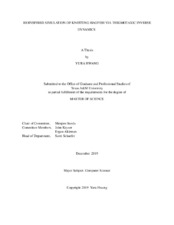Bioinspired Simulation of Knotting Hagfish via Thigmotaxic Inverse Dynamics
| dc.contributor.advisor | Sueda, Shinjiro | |
| dc.creator | Hwang, Yura | |
| dc.date.accessioned | 2020-08-26T18:25:17Z | |
| dc.date.available | 2020-08-26T18:25:17Z | |
| dc.date.created | 2019-12 | |
| dc.date.issued | 2019-11-26 | |
| dc.date.submitted | December 2019 | |
| dc.identifier.uri | https://hdl.handle.net/1969.1/188749 | |
| dc.description.abstract | Hagfishes are capable of not only forming knots, but also sliding them along the length of their bodies. This remarkable behavior is used by the animal for a wide variety of purposes, such as feeding and manipulation. Clearly of interest to biologists, this knotting behavior is also relevant to other fields, such as bioinspired soft robotics. However, this knot-sliding behavior has been challenging to model and has not been simulated on a computer. In this thesis, we present the first physics-based simulation of the knot-sliding behavior of hagfish. We show that a contact-based inverse dynamics approach works well for this challenging control problem, motivated by the biological concept called "positive thigmotaxis," the characteristics of organisms to be in direct contact with other objects in the local environment. | en |
| dc.format.mimetype | application/pdf | |
| dc.language.iso | en | |
| dc.subject | Simulation | en |
| dc.subject | Biology | en |
| dc.subject | Physics-based | en |
| dc.subject | Knots | en |
| dc.title | Bioinspired Simulation of Knotting Hagfish via Thigmotaxic Inverse Dynamics | en |
| dc.type | Thesis | en |
| thesis.degree.department | Computer Science and Engineering | en |
| thesis.degree.discipline | Computer Science | en |
| thesis.degree.grantor | Texas A&M University | en |
| thesis.degree.name | Master of Science | en |
| thesis.degree.level | Masters | en |
| dc.contributor.committeeMember | Keyser, John | |
| dc.contributor.committeeMember | Akleman, Ergun | |
| dc.type.material | text | en |
| dc.date.updated | 2020-08-26T18:25:18Z | |
| local.etdauthor.orcid | 0000-0001-5604-3817 |
Files in this item
This item appears in the following Collection(s)
-
Electronic Theses, Dissertations, and Records of Study (2002– )
Texas A&M University Theses, Dissertations, and Records of Study (2002– )


